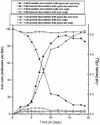Molecular phylogenetic exploration of bacterial diversity in a Bakreshwar (India) hot spring and culture of Shewanella-related thermophiles
- PMID: 12839826
- PMCID: PMC165147
- DOI: 10.1128/AEM.69.7.4332-4336.2003
Molecular phylogenetic exploration of bacterial diversity in a Bakreshwar (India) hot spring and culture of Shewanella-related thermophiles
Abstract
The bacterial diversity of a hot spring in Bakreshwar, India, was investigated by a culture-independent approach. 16S ribosomal DNA clones derived from the sediment samples were found to be associated with gamma-Proteobacteria, cyanobacteria, and green nonsulfur and low-GC gram-positive bacteria. The first of the above phylotypes cobranches with Shewanella, a well-known iron reducer. This phylogenetic correlation has been exploited to develop culture conditions for thermophilic iron-reducing microorganisms.
Figures


References
Publication types
MeSH terms
Substances
LinkOut - more resources
Full Text Sources
Molecular Biology Databases
Miscellaneous

